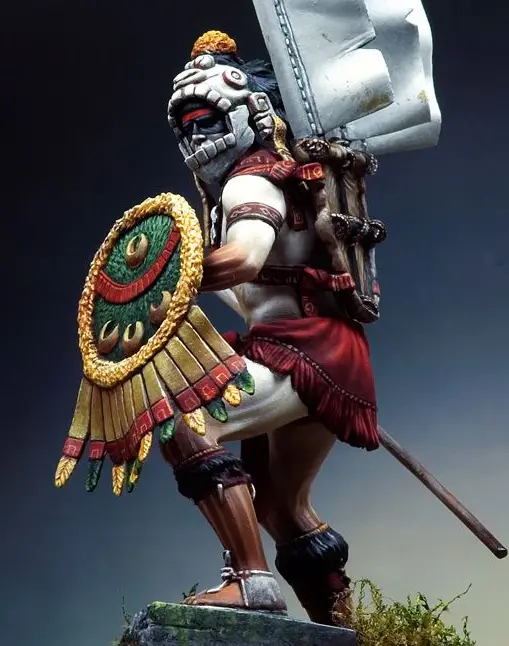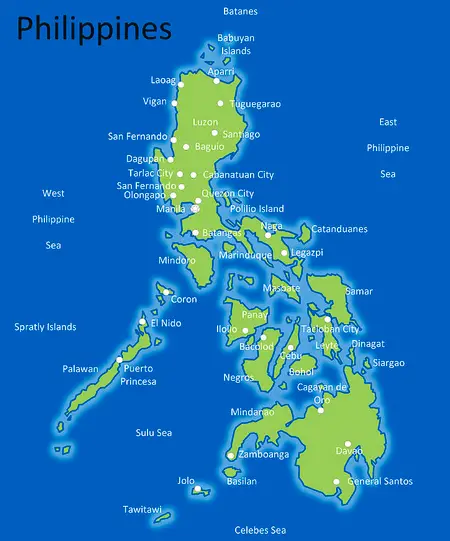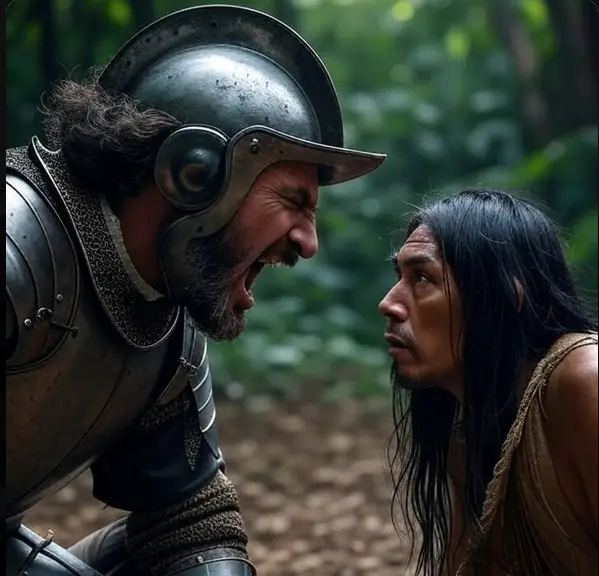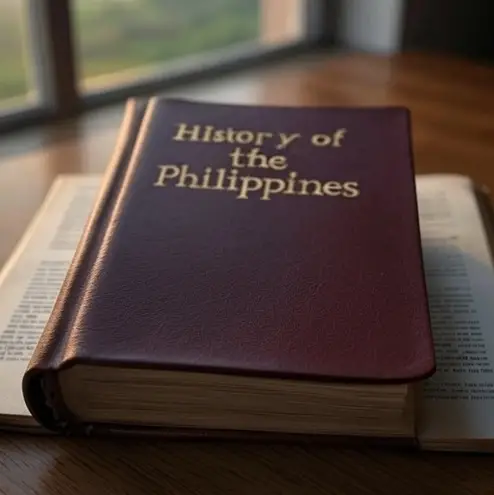Podcast: Play in new window | Download
Subscribe: Apple Podcasts | RSS
 When we think of the Spanish conquests in the Americas and beyond, names like Hernán Cortés and Francisco Pizarro often dominate the narrative. But behind these European figures stood a powerful indigenous force that shaped the course of history: the Tlaxcalans of central Mexico. These Nahua warriors, hailing from the small but fierce state of Tlaxcala, were instrumental not only in toppling the Aztec Empire but also in extending Spanish influence across the Pacific to the Philippines. In this episode of Mexico Unexplained, we’ll dive into the story of the Tlaxcalans—who they were, why they ventured thousands of miles to fight in the Philippines, the notable figures and battles they were involved in, and the lasting impact they left on those distant islands.
When we think of the Spanish conquests in the Americas and beyond, names like Hernán Cortés and Francisco Pizarro often dominate the narrative. But behind these European figures stood a powerful indigenous force that shaped the course of history: the Tlaxcalans of central Mexico. These Nahua warriors, hailing from the small but fierce state of Tlaxcala, were instrumental not only in toppling the Aztec Empire but also in extending Spanish influence across the Pacific to the Philippines. In this episode of Mexico Unexplained, we’ll dive into the story of the Tlaxcalans—who they were, why they ventured thousands of miles to fight in the Philippines, the notable figures and battles they were involved in, and the lasting impact they left on those distant islands.
To understand the Tlaxcalans’ role in the Philippines, we first need to know who they were and what drove them to become allies with the Spanish. The Tlaxcalans were a Nahua people, ethnically and linguistically related to the Aztecs, or Mexica, who spoke Nahuatl and shared similar cultural and religious worldviews. Their homeland, Tlaxcala, is Mexico’s smallest state today, covering just a little over 1,500 square miles, nestled between Puebla, Hidalgo, and the State of Mexico. In the pre-Columbian era, Tlaxcala was a confederation of four city-states—Ocotelolco, Quiahuiztlan, Tepeticpac, and Tizatlan—each with its own ruling lineage but united under a collective government often referred to by historians as the Republic of Tlaxcala. This structure made Tlaxcala unique, as it resisted the centralized imperial model of the Aztecs. For more information on pre-Hispanic Tlaxcala, please see Mexico Unexplained Episode number 327 https://youtu.be/rEpUN9XhsU0
By the early 16th century, Tlaxcala was completely surrounded by the Aztec Empire, which dominated central Mexico with an iron grip. The Aztecs imposed a trade embargo on Tlaxcala, depriving them of salt and other goods, and engaged them in the so-called “Flower Wars” or Xochiyaoyotl. These ritualized battles, fought from the 1420s to 1519, were not about conquest but about capturing warriors for human sacrifice, a practice central to both Aztec and Tlaxcalan cosmology. The Aztecs could have overwhelmed Tlaxcala and easily incorporated it into their empire but chose not to, likely to maintain a nearby source of sacrificial victims and to train their warriors. This perpetual state of conflict fostered deep resentment among the Tlaxcalans, who saw the Aztecs as their mortal enemies.
When Hernán Cortés arrived in Mexico in 1519, the Tlaxcalans saw an opportunity. Initially, they fiercely resisted the Spanish, clashing in battles at Tecoac and Tzompantepec with an estimated 30,000 to 150,000 warriors. Despite their numbers, the Tlaxcalans were impressed by Spanish weaponry—gunpowder, crossbows, and fierce war dogs—and their ability to withstand attacks. After three intense battles, Tlaxcalan leaders, including Xicotencatl the Elder and Maxixcatzin, lord of Ocotelolco, decided alliance was the better path. On September 23, 1519, they joined forces with Cortés, providing thousands of warriors, supplies, and strategic knowledge to defeat the Aztecs. This alliance was pivotal in the fall of Tenochtitlán on August 13, 1521, after an 80-day siege.
The Tlaxcalans’ loyalty earned them unique privileges in colonial New Spain. They were granted the right to carry weapons, ride horses, hold noble titles, and govern themselves autonomously. Tlaxcala was declared a ward of the Spanish Crown and was spared the encomienda system that enslaved other indigenous groups. Their warriors accompanied the Spanish in further conquests, from Guatemala to what is now the US state of New Mexico, cementing their reputation as indispensable allies.
 The Tlaxcalans’ journey to the Philippines in the 1560s was a natural extension of their alliance with the Spanish. In 1564, King Philip the Second ordered an expedition to claim the Philippines, named after him, and establish the Manila Galleon Trade Route, linking New Spain with Asia. Led by General Miguel López de Legazpi, the expedition aimed to colonize the islands, previously claimed by Ferdinand Magellan in 1521, and secure a foothold for Spanish trade and evangelization in the Far East.
The Tlaxcalans’ journey to the Philippines in the 1560s was a natural extension of their alliance with the Spanish. In 1564, King Philip the Second ordered an expedition to claim the Philippines, named after him, and establish the Manila Galleon Trade Route, linking New Spain with Asia. Led by General Miguel López de Legazpi, the expedition aimed to colonize the islands, previously claimed by Ferdinand Magellan in 1521, and secure a foothold for Spanish trade and evangelization in the Far East.
The Spanish faced logistical challenges: their forces were small, and the Philippines’ diverse, warlike tribes posed a significant threat. To bolster their numbers, the Spanish turned to their trusted Tlaxcalan allies. Historians estimate 200 to 400 Tlaxcalan warriors joined the expedition, sailing from ports like Acapulco or Barra de Navidad in Nueva Galicia which is now the modern Mexican state of Jalisco. The Spanish decision to include Tlaxcalans was strategic. Their proven combat skills, honed against the Aztecs and in campaigns like the Mixtón Rebellion from 1540 to 1541 discussed in Mexico Unexplained Episode number 88 https://www.youtube.com/watch?v=ZelnVjxcJJw and the Chichimeca Wars from 1550 to 1590 discussed in Mexico Unexplained Episode 142 https://youtu.be/p2e0fIy7Wg4 , made them ideal for overseas conquest. Additionally, their familiarity with Spanish military tactics and their willingness to fight for the Crown—often in exchange for privileges—made them a reliable asset.
The Tlaxcalans’ motivations were twofold. First, their alliance with the Spanish was a pragmatic choice to maintain their status and autonomy within the Spanish Empire. Participating in distant campaigns reinforced their privileged position. Second, some Tlaxcalans saw these expeditions as opportunities for adventure, land grants, increased wealth or social mobility, though records suggest not all were willing participants. A 1630 petition from the Tlaxcalan cabildo to the Spanish Crown complained of mistreatment by Spanish officers in the Philippines and Havana, indicating that some warriors may have been coerced or faced harsh conditions.
While specific Tlaxcalan individuals in the Philippines are less documented than in the Aztec conquest, a few figures stand out from the broader Spanish-Tlaxcalan alliance. Xicotencatl the Elder, a key Tlaxcalan lord, was instrumental in forging the initial alliance with Cortés, though he did not travel to the Philippines. His son, Xicotencatl the Younger, opposed the Spanish alliance and was executed for desertion in 1521, highlighting internal Tlaxcalan divisions. Maxixcatzin, lord of Ocotelolco, was another pivotal figure, providing thousands of warriors and supplies during the Aztec conquest, setting the stage for Tlaxcalan involvement in later campaigns. These leaders inspired new generations of Tlaxcalans to fight for the Spanish Crown. In the colonial period, Prospero Cahuantzi, a Tlaxcalan governor, promoted indigenous culture, reflecting the enduring legacy of Tlaxcalan identity, but also encouraged larger participation of Tlaxcalans in the affairs of the Spanish Empire, including overseas military campaigns and colonization efforts.
 In the Philippines, the Tlaxcalans participated in critical battles under General Miguel López de Legazpi’s command. On May 8, 1565, they landed in Cebu, engaging in a fierce battle against the native state ruled by the Raja of Cebu, the same group that killed Magellan in 1521. The Tlaxcalans’ obsidian-tipped war clubs and woven armor, lighter and more mobile than Spanish metal armor, gave them an edge in the tropical climate of southeast Asia. Their experience in Mesoamerican warfare, combined with Spanish firearms and tactics, overwhelmed the Cebuano defenders, securing a foothold for the Spanish. By 1571, the Tlaxcalans helped establish Manila as the colonial capital, fighting alongside the Spanish to subdue local tribes like the Kingdom of Tondo, governed by a local ruler called the Lakandula.
In the Philippines, the Tlaxcalans participated in critical battles under General Miguel López de Legazpi’s command. On May 8, 1565, they landed in Cebu, engaging in a fierce battle against the native state ruled by the Raja of Cebu, the same group that killed Magellan in 1521. The Tlaxcalans’ obsidian-tipped war clubs and woven armor, lighter and more mobile than Spanish metal armor, gave them an edge in the tropical climate of southeast Asia. Their experience in Mesoamerican warfare, combined with Spanish firearms and tactics, overwhelmed the Cebuano defenders, securing a foothold for the Spanish. By 1571, the Tlaxcalans helped establish Manila as the colonial capital, fighting alongside the Spanish to subdue local tribes like the Kingdom of Tondo, governed by a local ruler called the Lakandula.
While no single Tlaxcalan warrior is named in these battles, their collective impact was undeniable. A Spanish veteran’s 1624 pension request confirmed the presence of native soldiers in the Philippines, underscoring their role. The Tlaxcalans’ discipline and knowledge of coordinated warfare, perfected in the Flower Wars and Aztec campaigns, made them formidable against the fragmented Philippine tribes.
The Tlaxcalans’ influence in the Philippines extended beyond the battlefield, leaving a subtle but enduring cultural footprint in this southeast Asian island nation. Some Tlaxcalans, along with mestizos and Spaniards, settled permanently in the islands, particularly in areas like Cebu and Manila. Some Tlaxcalans were given land grants and special privileges in the new Spanish as promised by the Spanish king. The Tlaxcalan migration and integration introduced Nahuatl words into Philippine languages, enriching local vocabularies with terms like atole (a corn-based drink), camote (sweet potato), tamal (tamale), tianguis (market), tocayo (namesake), jicara (gourd cup), mecate (rope), and metate (grinding stone). These linguistic contributions reflect cultural exchanges between Mesoamerican and Filipino peoples, facilitated by the Tlaxcalans’ presence.
The establishment of Manila as the capital in 1571, supported by Tlaxcalan warriors, laid the foundation for the Manila Galleon Trade Route, which connected Asia, the Americas, and Europe for 250 years. This trade route transformed the Philippines into a global hub, with Manila becoming a melting pot of cultures. The Tlaxcalans’ role in pacifying local resistance ensured the stability needed for this economic system to flourish.
However, the Tlaxcalans’ legacy in the Philippines is less celebrated than in Mexico. Their small numbers and integration into colonial society meant they did not form distinct communities as they did in northern Mexico, where they founded settlements like San Esteban de Nueva Tlaxcala which is now part of Saltillo, and the Tlaxcala Barrio in Santa Fe, New Mexico. Still, their contribution to Spanish colonization helped shape the Philippines’ early colonial identity, blending indigenous Mesoamerican and Filipino elements under Spanish rule.
 The Tlaxcalans’ role in the Philippines and other conquests earned them a privileged status in New Spain, but it also left a complex legacy in Mexico. While they were hailed as heroes in colonial Tlaxcala, with works like the Lienzo de Tlaxcala depicting them as co-founders of New Spain, their collaboration with the Spanish led to a lasting stigma. In modern Mexico, some view them as traitors for aiding the conquest of other indigenous groups, a sentiment amplified after Mexico’s independence in 1821, when Tlaxcala lost its special privileges. This stigma persists, though it has softened, as seen in 2019 forums hosted by Mexico’s National Institute of Anthropology and History, which critically reexamined Tlaxcala’s role on the 500th anniversary of Cortés’ arrival.
The Tlaxcalans’ role in the Philippines and other conquests earned them a privileged status in New Spain, but it also left a complex legacy in Mexico. While they were hailed as heroes in colonial Tlaxcala, with works like the Lienzo de Tlaxcala depicting them as co-founders of New Spain, their collaboration with the Spanish led to a lasting stigma. In modern Mexico, some view them as traitors for aiding the conquest of other indigenous groups, a sentiment amplified after Mexico’s independence in 1821, when Tlaxcala lost its special privileges. This stigma persists, though it has softened, as seen in 2019 forums hosted by Mexico’s National Institute of Anthropology and History, which critically reexamined Tlaxcala’s role on the 500th anniversary of Cortés’ arrival.
For the Philippines, the Tlaxcalans’ impact was a footnote in a more massive colonial story, but the presence of the Tlaxcalans underscores a broader truth: the Spanish Empire’s success relied heavily on indigenous allies. Without the Tlaxcalans warriors’ tactical knowledge, and willingness to fight across oceans, the conquest of the Philippines might have faltered. Their story challenges the Eurocentric myth of a handful of conquistadors single-handedly toppling empires, revealing a more nuanced history of alliance, ambition, and cultural exchange.
 The Tlaxcalans were more than auxiliaries in the Spanish conquest; they were strategic partners who leveraged their alliance to secure their survival and influence. From their fierce resistance to the Aztecs to their battles in the steamy jungles of Cebu, the Tlaxcalans demonstrated resilience and adaptability. Their journey to the Philippines, driven by loyalty to the Spanish Crown and a desire to maintain their status, left a lasting mark on the islands through linguistic and cultural contributions. As we reflect on their legacy, the Tlaxcalans remind us that history is not just about conquerors but about the complex choices of those who shaped it, sometimes at great personal cost.
The Tlaxcalans were more than auxiliaries in the Spanish conquest; they were strategic partners who leveraged their alliance to secure their survival and influence. From their fierce resistance to the Aztecs to their battles in the steamy jungles of Cebu, the Tlaxcalans demonstrated resilience and adaptability. Their journey to the Philippines, driven by loyalty to the Spanish Crown and a desire to maintain their status, left a lasting mark on the islands through linguistic and cultural contributions. As we reflect on their legacy, the Tlaxcalans remind us that history is not just about conquerors but about the complex choices of those who shaped it, sometimes at great personal cost.
REFERENCES
-
González Acosta, Alejandro. “Migraciones Tlaxcaltecas hasta centro y sudamérica La otra Frontera: El Sur,” Revista de Historia de América, no. 129, 2001, pp. 103–44. http://www.jstor.org/stable/44732856.
-
González, Ana Carolina. “La alianza de los tlaxcaltecas con los españoles, el inicio de una larga amistad,” Noticonquista, UNAM, 2019.
